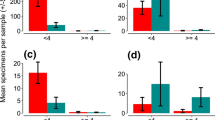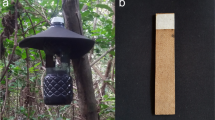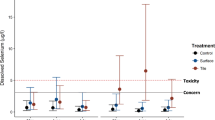Summary
Experimental studies support four main conclusions about the effects of the chemical composition of stemflow on the growth, development, and survivorship of larvae of the tree hole mosquito Aedes triseratus Say, a vector of human encephalitis. (1) The presence and type of leaf litter is more critical for larval growth and development than the type of stemflow found in tree holes. (2) However, variations in stemflow chemical composition within the natural range of concentrations have substantial effects on growth, development, and survivorship of the larvae. Effects of pH, ammonia, nitrate, and sulfate are especially pronounced. (3) Acidification of stemflow caused increased mortality, prolonged development times, and reduced size of individual pupae, similar to effects of acid precipitation on the insect detritivores of lakes and streams. The stimulatory effects of nitrate and sulfate in acid precipitation do not compensate for the deleterious effects of the acidity. (4) Changes in stemflow characteristics sometimes had opposite effects on detritivores and detritus. The vigor of the larval population was not dependent on litter decomposition alone. In general, emergence patterns of adult treehole mosquitoes depend strongly on the chemical composition of stemflow.
A fractional factorial experiment was successfully used. Fractional designs are advocated for experiments that screen a large number of nutrients or toxins for their effects on ecosystem components.
Similar content being viewed by others

References
American Public Health Association (1971). Standard methods for the examination of water and waste water
Box GEP, Cox DR (1964). An analysis of transformations. J Royal Stat Soc Ser B 26:211–257
Box GEP, Hunter WG, Hunter WS (1978). Statistics for experimenters. Wiley New York
Carlisle A, Brown AFH, White EJ (1967). The nutrient content of tree stem flow and ground flora litter and leachates in a sessile oak (Quercus petraea) woodland. J Ecol 55:615–627
Chefurka W (1965). Intermediary metabolism ofnitrogenous and lipid compounds in insects. In: M Rockstein (ed), The physiology of insecta, Vol II. Academic, New York p 670–768
Cronan CS, Schofield, CL (1979). Aluminum leaching response to acid precipitation: Effects on high-elevation watersheds in the northeast. Science 204:304–306
Eaton JS, Likens GE, Bormann FH (1973). Throughfall and stem-flow chemistry in a northern hardwood forest. J Ecol 61:495–508
Fish DF, Carpenter SR (in press). Leaf litter and larval mosquito dynamics in tree-hole ecosystems. Ecology
Gorham E (1976). Acid precipitation and its influence on aquatic ecosystems-an overview. In: LS Dochinger and TA Seliga (eds), Acid precipitation and the forest ecosystem. Gen Tech Rep 23: Forest Service, USDA
Hacker CS, Scott DW, Thompson JR (1973). Time series analysis of mosquito population data. J Med Ent 10:533–543
Hall RJ, Likens GE (1981). Chemical flux in an acid-stressed stream. Nature 292:329–331
Henderson GS, Harris WF, Todd DE Jr, Grizzard T (1977). Quantity and chemistry of throughfall as influenced by forest type and season. J Ecol 65:365–374
Hendrey GR, Baalsrud K, Traaen TS, Laake M, Raddum G (1976). Acid precipitation: some hydrobiological changes. Ambio 5:224–227
Jenkins DW, Carpenter SJ (1946). Ecology of the tree hole breeding mosquitoes of nearctic North America. Ecol Monogr 16:32–47
Kitching RL (1971). An ecological study of water-filled tree holes and their position in the woodland ecosystem. J Anim Ecol 40:281–302
Likens GW, Eaton JS (1970). A polyurethane stemflow collector for trees and shrubs. Ecology 51:938–939
Likens GE, Bormann FH, Pierce RS, Eaton JS, Johnson NM(1977). Biogeochemistry of a forested ecosystem. Springer, Berlin Heidelberg New York
Maguire B (1971). Phytotelmata: biota and community structure determination in plant-held waters. Ann Rev Ecol Syst 2:439–464
Merritt RW, Mortland MM, Gersabeck ER, Ross DH (1978). X-ray diffraction analysis of particles ingested by filter-feeding animals. Ent Exp App 24:17–34
Peterson JJ, Chapman HC (1969). Chemical factors of water in tree holes and related breeding of mosquitoes. Mosq News 29:29–36
Pichon G, Perrault G, Laigret J (1971). Parasite yield in filariasis vectors. Bull WHO 51:517–524
Reiners WA (1972). Nutrient content of canopy throughfall in three Minnesota forests. Oikos 23:14–22
Rudnick A, Marchette NJ, Garcia R (1967). Possible jungle dengue: recent studies and hypotheses. Jap J Med Sci Biol 20 (suppl): 69–74
Serie CL, Andral A, Poirier A, Lindrec A, Nerie A (1968). Studies on yellow fever in Ethiopia 6. Epidemiological studies. Bull WHO 48:879–884
Service MW (1976). Mosquito ecology. Applied Sci Pubs London p 583
Stobbart RH, Shaw J (1974). Salt and water balance; excretion. In: M. Rockstein (ed), The physiology of insecta, Vol IV. Academic New York p 362–447
Thompson WH, Anslow RO, Hanson RP, DeFoliart GR (1972). La Crosse virus isolations from mosquitoes in Wisconsin, 1964–1968. Amer J Trop Med Hyg 21:90–96
Voight GK (1960). Alteration of the composition of rainwater by trees. Amer Midl Nat 63:321–326
Wallace JB, Merritt RW (1980). Filter-feeding ecology of aquatic insects. Ann Rev Ent 25:103–132
Watts DM, Morris CD, Wright RE, DeFoliart GR, Hanson RP (1972). Transmission of LaCrosse virus (California encephalitis group) by the mosquito Aedes triseriatus. J Med Ent 9:125–127
Author information
Authors and Affiliations
Rights and permissions
About this article
Cite this article
Carpenter, S.R. Stemflow chemistry: Effects on population dynamics of detritivorous mosquitoes in tree-hole ecosystems. Oecologia 53, 1–6 (1982). https://doi.org/10.1007/BF00377128
Received:
Issue Date:
DOI: https://doi.org/10.1007/BF00377128



